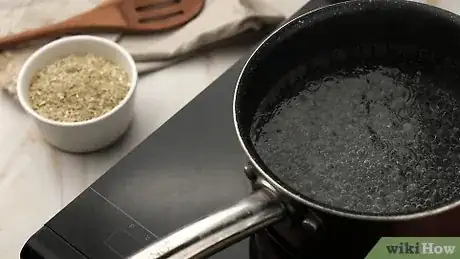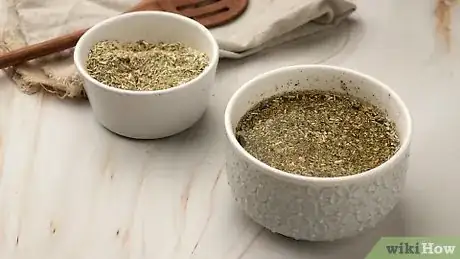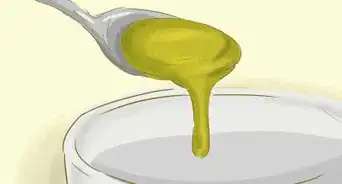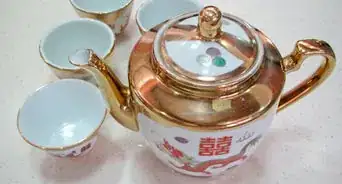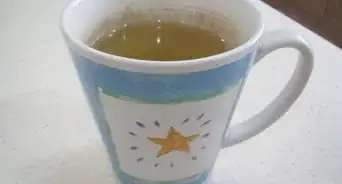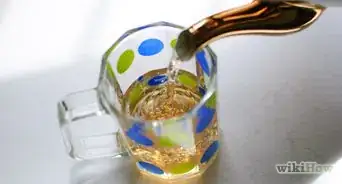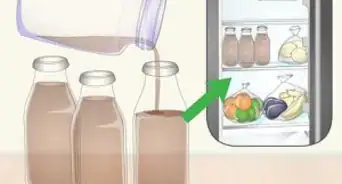This article was co-authored by Molly DeVoss and by wikiHow staff writer, Madeleine Criglow. Molly DeVoss is a Certified Feline Training and Behavior Specialist (CFTBS), a Certified Cat Behavior Consultant (CCBC), a Fear Free Certified Trainer (FFCT), and the Founder of Cat Behavior Solutions. Molly specializes in using positive reinforcement to modify and prevent unwanted behaviors in cats and reduce cat shelter surrender. Molly has sat on the Dallas Animal Advisory committee since 2013 and was voted one of the Top 12 Extraordinary Cat Behaviorists of 2020 by Catpetclub.com. She is certified by both the Animal Behavior Institute and the International Association of Animal Behavior Consultants. She is also the host of the weekly podcast Cat Talk Radio.
This article has been viewed 71,584 times.
Interested in brewing a delicious cup of tea for your kitty? Catnip tea is a yummy beverage that your cat will love, and it can even boost their mood. It's also super easy to make at home. Read on to learn everything you need to know about making catnip tea, from brewing to serving.
Steps
Brewing Catnip Tea
-
1Bring 2 cups (470 mL) of water to a boil on the stove. Pour the water into either a pot or a tea kettle. Then, place it on the stove and turn the heat on high.[1]
-
2Add 3 teaspoons (15 mL) of 100% pure and organic dried catnip to a mug. While you wait for the water to boil, prepare the catnip.[2] If you'd like, place a strainer over the mug and pour the catnip into the strainer. Otherwise, you can simply pour the catnip directly into the mug.[3]
- Opt for 100% pure and organic dried catnip to ensure that there aren't any pesticides or chemicals in the catnip. This variety is also much stronger!
- Using a strainer allows you to remove the leaves once your tea is done brewing. You also have the option of letting the catnip leaves float in the tea for a stronger beverage. Both are perfectly safe for your cat to drink.
Advertisement -
3Pour the hot water into the mug and let it steep for 3 minutes. Once the water has come to a boil, take it off the heat. Wait for the water to cool until it's no longer boiling, then pour it over the strainer (or simply into the mug if you're not using a strainer). Then, allow 3 minutes for the tea to steep.[4]
- Letting the tea steep for 3 minutes will ensure that the tea is strong enough for your kitty. Once that time is done, remove the strainer if you're using one.
-
4Let the tea cool to room temperature before serving it. To make sure your cat doesn't burn their tongue when they take a sip, avoid serving the tea hot. You might try waiting until the tea has cooled naturally, adding cool water to the tea, or keeping it in the fridge for a few minutes to let it chill.[5]
- Double-check the tea's temperature before serving it. To be absolutely sure the tea is no longer too hot to serve, try the tea yourself (catnip tea is safe for humans to drink, too).[6]
Serving Catnip Tea
-
1Serve the tea to your cat and wait for them to try it. Set the teacup near your cat to encourage them to drink it. They may be reluctant at first, but will likely try it once they smell the tea's enticing aroma.[7]
- If your cat isn't going for the tea, try a different serving style. Add some ice cubes to see if they'd rather drink iced catnip tea.
- It's possible your cat won't drink the tea, but will simply smell it. Don't fret, since even smelling catnip can boost your cat's mood and allow them to experience a moment of bliss.
-
2Give your cat catnip tea no more than once a day. Catnip overdoses are rare, but too much catnip can cause your kitty to experience an upset stomach. Excess catnip can also cause the ingredient to lose its relaxing effects over time. Give your kitty a little catnip throughout the week or once a day so your cat can keep experiencing its benefits![8]
-
3Store the remaining catnip in the freezer for up to 6 months. Catnip doesn't usually expire, but it can lose its effects over time. Keeping the catnip in an airtight container in the freezer will help it retain its potency.[9]
- Replace your batch of catnip after about 6 months. Though it won't harm your kitty, it will likely have lost its effects by this time.[10]
- Catnip does go bad if it gets damp, as this can cause the catnip to grow mold. Make sure to keep it in an airtight container to avoid any water exposure.
- The fastest way to a cat's heart is through its stomach.
- Providing regular meals and allowing the cat to approach you on its independent timeframe and comfort level are foundations for a successful relationship.
- Another way to encourage a cat to stay close is to plant catnip and provide a heated cat den in the winter.
References
- ↑ https://www.organicfacts.net/health-benefits/herbs-and-spices/catnip-tea.html
- ↑ https://nevadahumanesociety.org/news/catnip-tea-time/
- ↑ https://www.organicfacts.net/health-benefits/herbs-and-spices/catnip-tea.html
- ↑ https://nevadahumanesociety.org/news/catnip-tea-time/
- ↑ https://nevadahumanesociety.org/news/catnip-tea-time/
- ↑ https://www.humanesociety.org/resources/crazy-catnip
- ↑ https://nevadahumanesociety.org/news/catnip-tea-time/
- ↑ https://animalpath.org/how-long-does-catnip-last/
- ↑ https://www.humanesociety.org/resources/crazy-catnip
